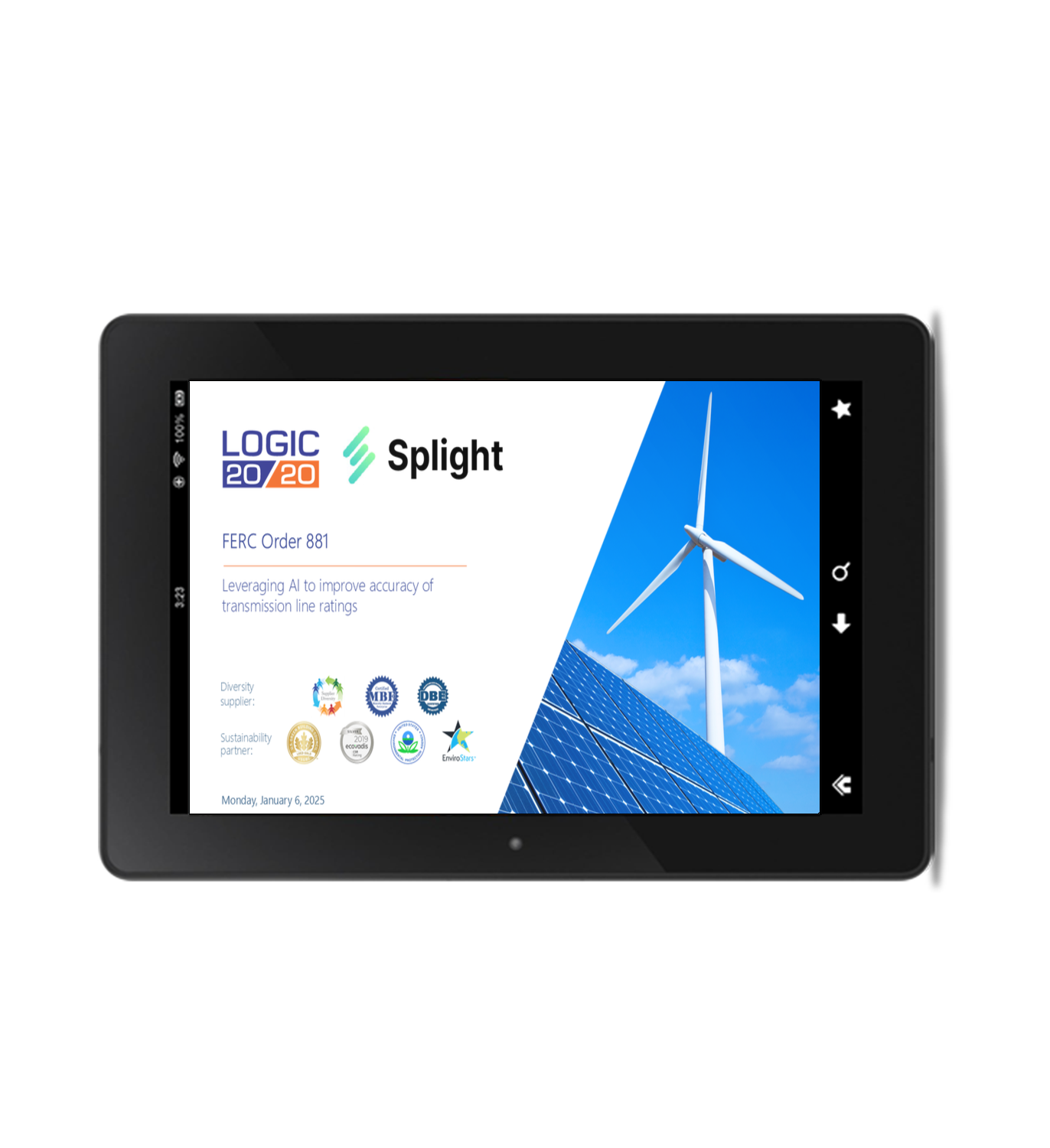Following is an excerpt from our webinar FERC Order 881: Leveraging AI to improve accuracy of transmission line ratings. Click here to access the replay and learn more about the transition from static/seasonal to ambient-adjusted and eventually dynamic line ratings.
The energy sector has arrived at a pivotal crossroads shaped by increasing demands for grid efficiency, reliability, and transparency. On December 16, 2021, the Federal Energy Regulatory Commission (FERC) issued Order 881—a transformative mandate aimed at modernizing how transmission line ratings are managed and implemented. This order represents a significant step forward in addressing inefficiencies in transmission capacity management, particularly as renewable energy integration and grid optimization become increasingly critical to the future of energy.
Transmission line ratings determine how much power can flow safely and efficiently through transmission lines. Traditionally, these ratings relied on static or seasonal methodologies, which often fell short of reflecting real-time grid conditions. The result? Underutilized capacity, increased congestion costs, and operational bottlenecks. FERC Order 881 seeks to remedy this disconnect by requiring the adoption of more dynamic and transparent rating practices, starting with ambient-adjusted ratings (AARs).
Article continues below.

What is FERC Order 881?
FERC Order 881, issued on December 16, 2021, is a landmark directive aimed at enhancing the accuracy and transparency of electric transmission line ratings. Recognizing the limitations of traditional rating practices, FERC introduced this order to modernize grid operations, ensuring transmission providers adopt more dynamic and responsive methodologies. This step is critical for optimizing grid capacity, integrating renewable energy, and reducing congestion costs while maintaining reliability and safety.
Key provisions include:
- Adopting ambient-adjusted ratings: Ratings that adjust based on near-term weather conditions, such as air temperature and solar heating
- Hourly updates: Transmission line ratings must be updated at least once per hour to reflect changes in ambient conditions.
- Enhanced transparency: Transmission providers must maintain a secure database of line ratings and methodologies, sharing this information with regional transmission organizations (RTOs), independent system operators (ISOs), and other stakeholders upon request.
- Emergency ratings: Providers are required to establish unique, case-specific emergency ratings for transmission lines.
Through these measures, FERC Order 881 aims to foster a more efficient, reliable, and transparent transmission system. By addressing the limitations of static and seasonal ratings, the order lays the foundation for future advancements in grid management, such as the broader adoption of dynamic line ratings (DLRs).
The evolution of transmission line ratings
As grid demands and renewable energy integration have grown, so has the need for more accurate and adaptive transmission line rating methodologies. The evolution of ratings reflects this shift, transitioning from static assumptions to dynamic, real-time assessments that better align with current grid realities.
Static line ratings: A legacy approach
Traditionally, transmission lines were rated based on static assumptions, considering worst-case scenarios such as the hottest days and minimal cooling from wind. While this conservative approach prioritized safety, it often left transmission capacity underutilized, especially during cooler or windier conditions when lines could safely carry more power.
Seasonal line ratings: Adjusting for broad environmental changes
Seasonal ratings represented the next step in adapting line ratings to environmental conditions, accounting for typical temperature and weather patterns during summer and winter. This adjustment improved capacity estimates but still relied on generalized assumptions that couldn’t address daily or hourly variability.
Ambient-adjusted ratings: Incorporating real-time conditions
AARs represent a significant leap forward, leveraging near-term weather data such as air temperature and solar heating to calculate transmission line ratings. By updating ratings at least hourly, AARs provide a more dynamic and accurate view of grid capacity, enabling better utilization of existing infrastructure.
Dynamic line ratings: The future of transmission line management
DLRs take accuracy and flexibility to the next level by incorporating real-time measurements and a broader range of variables, such as wind speed, cloud cover, and line tension. By using advanced sensors and algorithms, DLRs can reflect real-time conditions with high precision, unlocking additional capacity and reducing congestion costs.
To learn more about the future of transmission line ratings, watch the webinar today.
The shift from static to dynamic: Why now?
With FERC Order 881 mandating ambient-adjusted ratings and encouraging transparency, the energy sector is poised to embrace more accurate and adaptive rating methodologies. But why is this shift happening now?
Evolving grid demands
The grid is undergoing a significant transformation, driven by the rapid integration of renewable energy sources and increasing electricity demand. Wind, solar, and other renewable energy sources introduce variability into the grid that static ratings cannot accommodate. AARs, and eventually dynamic line ratings, enable grid operators to align transmission capacity with real-time conditions, optimizing the use of existing infrastructure and reducing the need for costly upgrades.
Underutilized capacity and rising costs
Static ratings often underestimate a line’s true capacity, particularly in cooler or windier conditions. This underutilization leads to unnecessary congestion and increased operational costs. By contrast, dynamic ratings capture real-time variations in line capacity, allowing utilities to reduce congestion costs and maximize the efficiency of their existing assets.
Regulatory and environmental pressures
FERC Order 881 reflects broader regulatory and environmental goals, such as enhancing grid reliability and accelerating the integration of renewable energy. With federal mandates pushing for hourly updates to ratings and the use of more precise methodologies, utilities face a clear imperative to adopt AARs and move toward DLRs. This transition aligns with the energy sector’s shift toward sustainability and reduced carbon emissions.
Advances in technology
The availability of advanced sensors, real-time data analytics, and robust forecasting models has made dynamic ratings more accessible and practical. Innovations in grid management systems, such as those integrating DLRs, enable transmission providers to adopt these new technologies with minimal disruption, paving the way for a smarter, more resilient grid.
FERC Order 881 as a catalyst
FERC Order 881 not only mandates compliance with AAR methodologies, but also establishes a framework for the broader adoption of dynamic ratings. By requiring hourly updates and greater transparency, the order encourages utilities to leverage advanced technologies and data-driven insights to enhance operational flexibility and grid reliability.
Unlocking the future of grid modernization with FERC Order 881
FERC Order 881 is more than a regulatory mandate—it’s a pivotal step toward transforming the energy grid for a more reliable, efficient, and sustainable future. By advancing transmission line rating methodologies from static and seasonal approaches to real-time, dynamic systems, the order unlocks untapped grid capacity, reduces operational inefficiencies, and supports the seamless integration of renewable energy.
As utilities navigate the path to compliance, they have an unprecedented opportunity to modernize their systems, adopt innovative technologies, and align with broader energy transition goals. The journey to grid modernization begins with understanding the implications and opportunities presented by FERC Order 881.

